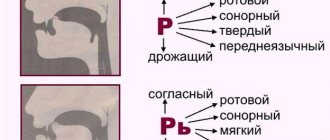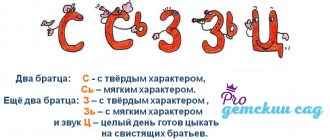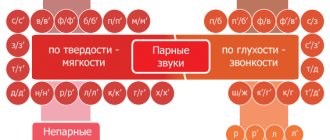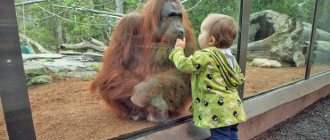Speech therapy manual “Speech”
The purpose of this manual: Using visual aids, increase the effectiveness of speech therapy, generate interest in classes, and create positive motivation in children with speech disorders.
Tasks:
— expansion and enrichment of vocabulary on lexical topics;
— development and improvement of the grammatical structure of speech;
— automation of sounds in speech;
— development of visual gnosis;
— learn to establish logical connections between objects;
— development of phonemic hearing, analysis, synthesis;
— development of coherent speech skills;
- development of spatial concepts, mathematical concepts, perception of color, shape, size;
— development of mental processes (attention, perception, memory, logical thinking);
- development of fine motor skills.
The main job of a teacher-speech therapist is to develop all aspects of speech in children. Often speech therapists are in dire need of didactic and gaming aids, since repeated repetitions of the same material tire not only the child, but also the adult. And then the speech therapist has to figure out how and how to diversify the classes so that the material being worked on does not bore the child and is interesting for him. After all, only positive motivation will contribute to effective work, which will subsequently lead to the desired result.
It is this fact that leads to the search for new methods of work, new universal aids that make it possible to work on the formation of all aspects of a child’s speech.
The “Rechevichok” manual corresponds to a system-active approach, is accessible and safe. The Velcro album helps to work on the development of all aspects of speech, from consolidating correct sound pronunciation to working on the formation of coherent speech. The exercises offered to children help not only eliminate speech disorders, but also contribute to the formation of attention and memory, increase efficiency, activate mental operations, and prepare children for school.
The work uses visual aids in the form of bright and interesting laminated pictures - bases with silhouettes and contour drawings, and pictures on Velcro, stickers and toys, which allow a beneficial effect on the emotional state of children, maintain interest in classes, and form voluntary attention when working with the proposed material.
This manual is intended for different age categories (from 3 years to 7 years). The manual can be used both in individual work with a child and in working with two children at the same time, since it has two and three working surfaces. It is also possible to perform exercises as a team.
“Speech” can be used by educators in classes on speech development and literacy. This fact is very important, because the teacher-speech therapist has the opportunity to recommend consolidation of certain speech skills and help in the selection of visual material (interaction with kindergarten teachers and specialists).
The relevance of this manual lies in the fact that when working with children with speech impairments, it can be very difficult to interest and retain their attention, to awaken interest in the content of the lesson and the learning process as a whole. The use of this game aid facilitates the learning of educational material by children and increases the effectiveness of speech therapy work. The versatility of the manual is expressed in the variety of didactic material that can be used in accordance with the intended purpose. The manual is multifunctional, its use depends on the tasks of the speech therapist in a particular lesson. Pictures from one game can be peeled off and used in other games.
Thanks to the use of Velcro games, the learning process takes place in an accessible and attractive environment for preschool children. The manual can be supplemented as necessary with other games and details. It is convenient to put away parts that were not needed for a particular lesson in the pockets located in the folder. Working with this manual allows you to systematize all the visual material available to the teacher-speech therapist and use it productively in the classroom.
Below are examples of using the “Speech” manual.
Game “Glue the flowers and butterflies yourself”
Goal: learning and consolidation of color, development of thinking, development of visual concentration.
The child needs to find a picture by color and glue it to a house or flower.
You can immediately offer the child games - tasks: “One - many”, “Which picture is the odd one out?”, “Who-what?”, “Make a sentence.”
Game “What fruits and berries do you know?”
We make speech therapy games and manuals ourselves
When making speech therapy games with your own hands for preschoolers, you need to be sure that they are colorful and exciting for kids. The child likes to play, and the speech therapist must organize this in such a way that the violations are corrected.
Speech therapist works with a child
Aids for the formation of subject activity
Sometimes speech disorders are associated with insufficient development of fine motor skills or intellectual activity. You can create speech therapy aids with your own hands to correct such problems.
We are working on sensory skills: the game “Locks”
Important! The game "Locks" will help children develop the necessary qualities.
Before you start, you need to prepare several multi-colored zippers (at least 6 pieces of different colors). They are laid out horizontally, one under the other, in front of the child. The child is given various types of tasks:
- Find a castle of a certain color.
- Close or open one whose name contains a specific letter.
- Talk about your actions.
- Count out loud the castles of a certain color.
At the same time, speech skills and fine motor skills of hand movements develop.
Game "Put a butterfly on your path"
In this game, stripes (paths) are made from felt of certain colors. There must be at least six of them. Flat figures of butterflies made from cardboard must be placed on a path of a certain color. This may include the following tasks:
- Place a certain number of blue figures on the corresponding path.
- Count the number of butterflies out loud, indicating their color.
With each action, the child must describe what he is doing according to the instructions of the teacher.
“Sound clearings” for sound automation
For this game, draw a winding path on a piece of paper. At the beginning they place a dog, at the end - a booth. There are bones on the road that need to be collected. The baby leads the toy along the path, imitating its growl. When it is in the spaces between the bones, the child pronounces “r-r-r-r-r-r” long and with effort. He rests at the bone, making short and light “r” sounds. In this way, the pronunciation of this sound is automated.
Sound glade
Collecting an album of cards for the development of fine motor skills
Tasks for the development of children exist in a large number of options. It is advisable to collect them in an album, each page of which represents a separate task.
Speech therapy mat made of squares
If you make a rug with squares and attach small objects to each of them, then the kids can be given various tasks related to them. For example, they can choose objects of a certain color by counting and naming them.
Collecting pictures by topic to work on sounds
The child can describe the contents of pictures and make sentences related to them. Having collected a thematic collection, he will perform tasks related to individual pictures or their groups, describing his actions in words.
Homemade products for the development of fine motor skills from scrap materials
By making games and tasks for children with your own hands, you can help develop their intelligence and speech skills.
"Lacing"
For this type of game, you can print out the images and stick them on hard paper. At the same time, some of the details that need to be added are designed in such a way that the laces can be threaded in this place and a complete plot is obtained. For example, you can depict a cloud and prepare the holes so that the lace imitates raindrops.
Templates of speech therapy characteristics for children of different levels for PMPC
Important! Various plots can be used. For example, lacing can represent the spokes of a bicycle or outline the desired contour.
Speech therapy walks
You can use a computer to work with children. To do this, just use a presentation program (for example, Microsoft PowerPoint). In this case, on the picture that is used to create the background, several images of objects are placed and sounds are attached to them. On this basis, you can create various speech therapy games. Here are some of them:
- The child touches several pictures and loudly pronounces the names of the objects. He chooses those that give the same sound. For example: “One Christmas tree, two Christmas trees.” To study adjectives, you can say: “One green Christmas tree, two green Christmas trees.”
- Invite your child to choose three items he likes from those offered and make sentences with each of them. For example, if he chose a fish, dishes and an apple, he can say: “The fish is swimming in the aquarium,” “Peter ate the apple,” and “Dad bought the dishes.”
- You can play the game "Greedy". To do this, the child selects several objects (for example, a Christmas tree, a cake) and says “My tree,” “My cake.” You can suggest a similar game “Don't be greedy”. Having chosen pictures with a hat and a bicycle, the kid says: “I gave everything away and I don’t have a bicycle, I don’t have a hat.”
Based on one or two pictures with pictures, you can come up with a large number of this type of speech therapy games.
Action
This category of homemade speech therapy aids for preschoolers includes labyrinths. They are drawn on a piece of paper. A simple labyrinth is created for the child, inside which a large number of objects are located. The child throws the dice and moves towards the goal, loudly and clearly pronouncing the names of the objects through which he passes. The drawings are selected according to such a scheme so that the game helps the baby master certain sounds. Usually several variants of such labyrinths are used.
Tactile pouch
For this didactic game you need to sew two types of bags:
- Opaque - you can’t see what’s inside, but you can feel it. They are made square with a side of no more than 10 centimeters.
- The transparent ones have one side made of plastic. To do this, you can use the material from which transparent files are made. The other side is made of fabric.
The bags are filled with various types of fillers so that they can be easily distinguished by touch. They must be paired. Each variety should be in one transparent and one opaque bag.
Pouches
Here are examples of games that can be played with children:
- First, examine the contents of one of the transparent bags. It is examined, felt and the contents described. Then they look for the same filler in an opaque bag.
- They look for the right material by touch. Then they point to a transparent bag with the same filling. Describe what they contain. As a result, you need to line up two rows. In this case, bags with the same contents should be located together.
Such activities develop visual and tactile analyzers and teach children to speak correctly.
Another DIY speech therapy game is used, in which several objects are placed in a bag. Children must touch what is there, take it out and describe it in words.
Speech therapy classes - Summary of speech therapy classes on automation of sounds [P] and [P']
Publication “Summary of a speech therapy lesson on the automation of sounds [P] and...” Synopsis of an open speech therapy lesson on the automation of sounds [p] and [p']. Prepared by: teacher-speech therapist Safonova K.D. With. Shiloksha, 2021 Goals: automation of sounds [р] and [р'] in syllables, words and sentences, formation of knowledge, skills and practical skills of safe...
Image library "MAAM-pictures"
Summary of individual speech therapy lesson “Differentiation of sounds [s] - [w]” Topic: sounds [s] and [sh]. Goal: differentiation of sounds [s] and [sh] at the beginning, middle and end of a word. Objectives: 1. Development of the ability to distinguish between sounds [s] and [w] at the beginning, middle and end of a word; 2. Clarification of articulation and characteristics of sounds [s] and [sh]; 3. Development of phonemic…
Abstract of an individual speech therapy lesson “Automation of the sound [w] in words” Topic: Sound [w]. Goal of the lesson: automation of the sound [sh] at the beginning of a word. Objectives of the lesson: 1. Reinforce the correct articulation of the sound [w] at the beginning of a word; 2. Clarification of the articulation of the sound [sh]; 3. Development of phonemic representations; 4. Development of a smooth long exhalation; 5….
The use of psychogymnastics exercises by M.I. Chistyakova in speech therapy classes Psychogymnastics is a set of special exercises aimed at developing the emotional-volitional sphere, communication skills, as well as combating various psychological problems. The main advantages of psycho-gymnastics: • the playful nature of the exercises (reliance on the leading…
Topics for classes for speech therapists
When working with children, a speech therapist can take on many different topics. helping kids develop speech skills. Below are some of the most popular options.
Lesson topics for the preparatory group
It is important to use physical education minutes in every lesson and make it an exciting game for children.
Speech therapy exercises for children from 5 to 6 years old at home
Theme "Professions"
During these classes, various specialties are considered, involving children in games and a variety of activities. They are given riddles related to the activities of adults. Children are given exercises that imitate the movements of workers.
Conducting a speech therapy lesson in the preparatory group on the topic “Professions”, children are taught to talk about various types of occupations of adults.
Various sounds and words are pronounced with children, they are taught to make facial movements expressing certain emotions.
Theme "Winter"
When a speech therapy lesson is held on the topic “Winter,” riddles are offered on the topics of winter weather and events related to this period. Conversations related to this time of year are held with children. Kids are asked to describe winter weather using different words. For example, “What the frost does / Pinches, bites.”
Theme "Transport"
The children are considered different types of transport and given tasks that relate to them. For example, kids look at cards with pictures and must determine which is the odd one out (pictured: a car, a train, an airplane and a pan). Children must explain their choice. You can do the exercise “The steamer is humming”, used in speech therapy.
Note! In this case, while exhaling with their mouth closed, children should pronounce the long sound “oo-oo-oo”.
Furniture theme
Boys and girls of preschool age are asked to name pieces of furniture located in the room. They are asked what different parts of a chair, table or cabinet are made of. A game can be used when the qualities of furniture are named, and the child must name the opposite property.
Theme "Indoor plants"
You can play the game "To". Children are told how to care for plants, and they must add the word “to” and say why exactly this should be done. The “Two and Five” game involves saying a sentence like “I have two cacti and five cacti” about various houseplants. Children with OHP are asked to say various sentences, talking about what the ladybug does. For example: “A ladybug flies over a flower.”







